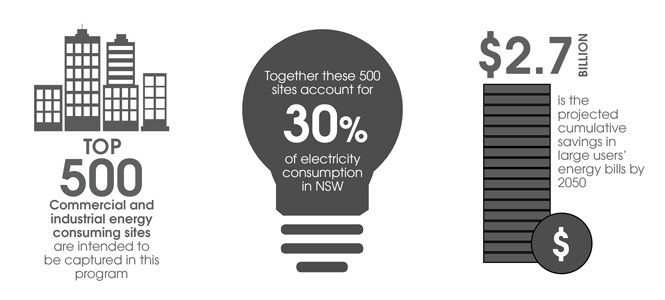On 3 November, the NSW Government announced a target to achieve net zero emissions by 2050 as the basis of a new and comprehensive climate change policy framework. The target is an important signal to large emitters of the need to reduce the carbon intensity of their operations. However, perhaps the greatest significance lies in the fact that this is an initiative of a Liberal-National state government, whereas other net zero emissions targets set by state governments to date, have all been under ALP administrations.
In this article we focus on the features of the draft energy efficiency opportunities program that bears strong similarities to the Energy Efficiency Opportunities (EEO) scheme operated by the Federal Government until 2014. From Energetics’ experience, an EEO-style scheme offers business multiple benefits, and should be viewed as an opportunity, rather than simply as a compliance exercise.
As part of an integrated climate plan, the Government has proposed a scheme requiring the State’s largest energy users to identify and report energy efficiency opportunities in their businesses. The program is intended to capture the state's top 500 commercial and industrial energy sites/users, which together account for over 30% of electricity consumption.
However, much like the now-defunct Federal Government EEO scheme, there would be no obligation to implement the identified opportunities. That said, the state government is hopeful that identified opportunities will win internal support and be implemented. It is hoped that the program will deliver annual savings of 1% in the electricity consumption of large users, and see a reduction in the energy bills of large energy users in the order of $2.7 billion between now and 2050. The draft scheme outline further states, "If the voluntary uptake of cost-effective energy efficiency projects identified in plans is insufficient, the NSW Government would consider a stronger framework to drive opportunities in the future”.

Financial assistance
The NSW Government has indicated that it would make up to $200m in financial support available through the Climate Change Fund to assist in this new energy efficiency drive, amongst other emissions reduction measures. Certainly the Fund would help large energy users prepare plans.
A draft strategic plan for its Climate Change Fund was released which includes actions to facilitate funding for identified opportunities through the continuous improvement of the NSW Energy Savings Scheme, improve contracts and business cases for the uptake of Environmental Upgrade Agreements, and expand on new innovative financing models such as green bonds and rate based financing to facilitate project implementation.
Exemptions for those already using best practice energy management
An important feature outlined in the draft scheme design is that large energy users could be granted an exemption from preparing a plan if they can show that they are already implementing best practice energy management.
Energetics advises that those previously reporting under the Federal EEO scheme should revisit their plans and review the level of energy management within their business to understand how closely its elements map to best practice systems, such as ISO 50001.
A broader, national aim
There are additional features that the NSW Government is hoping to achieve that are designed to ensure that NSW’s energy productivity measures are complemented with broad action. The plan also proposes that the state government pushes for:
- A strengthening of the federally-administered GEMS program that sets minimum efficiency standards for appliances and equipment.
- That the Australian Building Codes' Board introduce stronger energy standards for commercial buildings.
- An extension of the Federal Commercial Buildings Disclosure scheme so that shopping and data centres are required to disclose their energy performance, not just office blocks.
- The introduction of a state point-of-sale energy ratings scheme for new homes and introducing performance standards to improve the energy performance of tenanted properties.
- Encouragement of businesses, institutions and local councils to form renewable energy buyers groups.
Immediate considerations and steps to take
1. Participate in the consultation process.
Large energy-using organisations can provide feedback on the draft plan. The Government is seeking to understand the value that could be delivered to business and their requirements to support its efficient implementation. Consultation closes 16 December. You can read more via this link.
2. Determine whether one or more of your sites is included in the top 500.
This may include individual sites that currently meet the facility threshold under NGER, or sites previously assessed under EEO or that participated in the development of NSW Energy Savings Actions Plans (ESAPs).
3. If you think you might be included, review your energy management systems and consider seeking an exemption.
Where sites have previously participated in EEO or ESAPs, Energetics can help you to resurrect your EEO program and demonstrate how this is best practice energy management. The case can be supported by conducting an ISO50001 gap assessment or One2Five® diagnostic to fast track your organisation to ISO50001 compliance. With these steps your organisation may be granted an exemption from formal participation.
Energetics had extensive involvement in the EEO program when it was running, consulting to more than 40% of participants. Our One2Five® energy management diagnostic tool can help you benchmark and prioritise actions to improve energy management systems. This tool uses similar criteria to ISO50001 and the results of the diagnostic can be mapped against the standard.
Please contact the author, Leigh Rostron, or any one of our experts for advice.



